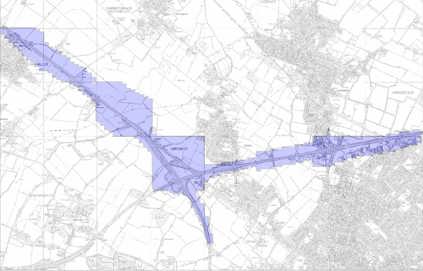Local air quality management
The requirements of Local Air Quality Management (LAQM) as set out in Part IV of the Environment Act (1995) places an obligation on all local authorities to regularly review and assess air quality in their areas, and to determine whether or not the air quality objectives are likely to be achieved. Where an exceedance is considered likely, the local authority must declare an Air Quality Management Area (AQMA) and prepare an Air Quality Action Plan (AQAP) setting out the measures it intends to put in place, in pursuit of the objectives.
The objectives to be met by local authorities are detailed in the table below:
|
Pollutant |
Air Quality Objective Concentrations in microgram (µg) per cubic meter (m3) |
Air Quality Objective: Measured as |
|
Nitrogen Dioxide (NO2) |
200µg/m3 not to be exceeded more than 18 times a year |
1-hour mean |
|
Nitrogen Dioxide (NO2) |
40µg/m3 |
Annual mean |
|
Particulate Matter (PM10) |
50µg/m3, not to be exceeded more than 35 times a year |
24-hour mean |
|
Particulate Matter (PM10) |
40µg/m3 |
Annual mean |
|
Sulphur Dioxide (SO2) |
350µg/m3, not to be exceeded more than 24 times a year |
1-hour mean |
|
Sulphur Dioxide (SO2) |
125µg/m3, not to be exceeded more than 3 times a year |
24-hour mean |
|
Sulphur Dioxide (SO2) |
266µg/m3, not to be exceeded more than 35 times a year |
15-minute mean |
Annual Status Report (ASR) is an annual requirement showing the strategies employed by local authorities to improve air quality and any progress that has been made.
Annual Status Reports (ASR)
One of the requirements for local authorities as part of the LAQM process is to produce an Annual Status Report (ASR) each year, containing an overview of air quality in the district during the previous year. We have monitored and reported on local air quality annually since 1998. The most recent reports are available below.
- Annual status report 2024 [PDF, 5MB]
- Annual status report 2023 [PDF, 1.5MB]
- Annual status report 2022 [PDF, 1.5MB]
- Annual status report 2021 [PDF, 2MB]
- Annual status report 2020 [PDF, 2MB]
Should you require previous reports, please send a request to air.quality@scambs.gov.uk
Air Quality Monitoring
Details of our 3 continuous monitoring sites, including maps and live data from these sites can be viewed at the South Cambridgeshire air quality and monitoring sites details dashboard.
Air Quality Strategy
Following the revocation of the Air Quality Management Area (AQMA) in January 2022, our Air Quality Strategy was adopted. In April 2024 our Air Quality Strategy was replaced with a new Greater Cambridge Air Quality Strategy [PDF, 0.5MB], which is a joint strategy with Cambridge City Council.
The primary objectives of the Strategy are:
- continue to meet and deliver all legislative and policy requirements associated with air quality
- continue to improve air quality across Greater Cambridge enhancing the health of those living, working and visiting Greater Cambridge
- work towards World Health Organisation Air Quality Guideline annual averages as longer term targets with interim targets for delivery within the lifetime of the Strategy (5 years).
The objectives of the Strategy across Greater Cambridge will be delivered under 4 key priority areas; Regulatory Policies and Development Control, Infrastructure Improvements, Community Engagement and Promotion and Monitoring. The Strategy includes an Action Plan of measures for delivering air quality improvements for delivery within the lifetime of the Strategy. The lifetime of the Strategy is 5 years, from 2024 to 2029.
Revoked Air Quality Management Area (2008 - 2022)
The area of the A14 between Milton and Bar Hill was designated as an Air Quality Management Area (AQMA) for exceedances of the national objectives for annual mean nitrogen dioxide and daily mean particulate matter (PM10).

Reproduced from the 2007 Ordnance Survey mapping with the permission of the controller of Her Majesty's stationary office (c) Crown Copyright. Unauthorised reproduction infringes Crown Copyright and may lead to prosecution or civil proceedings.
Low Emission Strategy and air quality in planning
Air quality is an important consideration in planning applications for major developments. As outlined in the 2018 South Cambridgeshire Local Plan, a Low Emission Strategy (LES) will need to be submitted alongside planning applications for major developments requiring a Transport Assessment and Travel Plan and developments with significant transport implications.
Low Emission Strategies provide a package of measures to help mitigate the transport impacts of development on local air quality and on climate change. They complement other design and mitigation options, such as travel planning and the provision of public transport infrastructure. Strategies are often secured through a combination of planning conditions and planning obligations. They may incorporate policy measures and / or require financial investments in and contributions to the delivery of low emission transport projects and plans, including strategic monitoring and assessment activities.
Full details of when a Low Emission Strategy will be required and our preferred sustainable transport measures to be included within any LES can be found in the Greater Cambridge Sustainable Design and Construction Supplementary Planning Document, in the section Air Quality – South Cambridgeshire.

